
 |
Music Notes & Events: |
 |
|
Chamber Music for Guitar with the JH Symphony |
||||
| The Boccherini Quintet "Fandango" ; | ||||
| 2.Oct.2011 at the new Moose Visitor Center concert hall 2pm; | ||||
"The Alliance" video released |
||||
| A film by Charlie Craighead for the Jackson Hole Conservation Alliance; | ||||
| Byron Tomingas created the music tracks including excepts from "Birds of Amber" | ||||
|
||||
| By Metafilm featuring many wonderful musical personages including; | ||||
| Byron Tomingas playing an exerpt of his composition "Animal Tracks" | ||||
|
||||
| By Horizon Pictures commemorating the Teton Village Tram | ||||
| With original music by Tomingas & a short interview | ||||
|
||||
| Videos of figure skaters with live music played by Tomingas at 10 degree's plus a high wind chill....yeoww | ||||
Pending: "Spring Concert at the Museum of Wildlife Art" |
||||
| Featuring the natural wildlife films of Bob Tomingas | ||||
| Also ask for Byron's CD's & Video's at the Museum of Wildlife Art | ||||
Pending: "Byron's annual Birthday Concert 28th June |
||||
| Traditionally held at Byron's birth location; St. John's Church downtown Jackson Hole | ||||
| Note: ActiveX might need to be enabled to see the video inserts, click the highlighted bar at the top |
Byron Paul Tomingas has appeared
as soloist, with chamber groups and Symphonic Orchestras
on stage, live radio and as the feature in more than 20 Public Broadcast television
productions. Instructor to
multiple thousands of students and Composer of award winning film scores
Tomingas has received such concert reviews as: “Enchanted Animation,” “Brilliant,”
“Splendid Musicality” for his Classical and Originals
concerts.
|
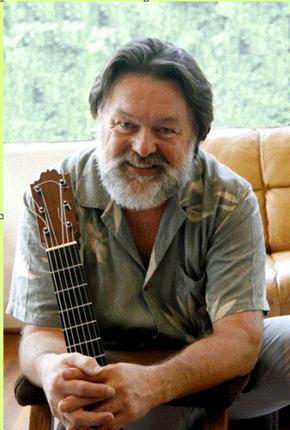 |
While consistently receiving standing ovations, appearances are as rare as recordings by this artist. The few recordings are usually very limited release items to celebrate an event and are often filled with a blend of classics, original works, transcriptions and song arrangements. Tomingas withdrew from major concert stages a decade ago in favor of a quieter, simpler life. The best chance one has of hearing Tomingas play is at the Jackson Hootenanny or catch one of his local concerts, otherwise, you might have to stroll the quiet evening streets of Jackson Hole at the foot of SnowKing Mountain, listen carefully, and you will likely hear a stream of music on a gentle breeze.
|
|
Photo by Jose Oribe |
|
|
|
|
|
Concert Guitarist Byron
Paul Tomingas |
|
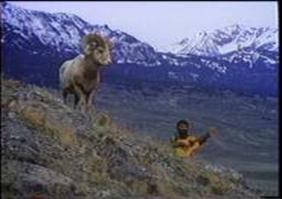 |
Maestro Tomingas is a unique
concert artist with a warm, humorous, outdoor, adventurous spirit that
“enchants” his performances with programming of romantic and energized
music targeted to the “hearts of concert audiences” (Guy
Horn, composer). Classic Commentator Euell Labahrd called Tomingas “A leading force in music”
|
| Natural photo by Bob Tomingas | |
| (Byron's Father) | |
Master composer Roman Ryterband
wrote significant music (now in the Harvard Archives) for the instrument
after hearing a performance by Byron Tomingas. Tomingas has appeared in
several movies as well as composing music for award winning films. Students of Byron Tomingas have also
been featured in many television productions, concerts and are highly regarded
by the industry in their own right. |
|
Byron Tomingas has taught multiple
thousands of successful students at colleges, privately and in Master Classes
with such reviews as: “Phenomenal,”
“Determined, Skillful and Articulate”. He received his Bachelor of Music with
Graduate Studies from the prestigious California Institute of the Arts where
he studied intensively with such notables as: Sitar Master Ravi Shankar,
Conductor Leonard Stein, Composer Harold Budd, Roth Quartet Chamber Cellist
Cesare Pascarella, and Electronic Music Composer/Innovator Morton Subotnik (2001 Space
Odyssey). Tomingas also received
the honor of being nominated to one of legendary Maestro Andres
Segovia’s last master classes in Spain. The award winning documentary
“The Bountiful Harvest of Steinbeck Country” soundtrack was
composed and performed by Tomingas. Byron also made his own short film productions two of which were
recently shown at the Eastman Film Festival in Los Angeles. Maestro Tomingas
was a Founding Board Member of the highly successful Carmel Classic Guitar
Festival in California.
|
Byron Tomingas, as a single parent
withdrew from major public performances in 1994 to raise his then 3 year old
daughter quietly, compose, pursue his love of the outdoors and technical
innovation more vigorously. Now
that his daughter is in her teens, he has returned to the concert stage;
“Our magnificent guitarist”, “stunning the audience”
once again, although only in Jackson Hole WY.
|
| Return to Top
|
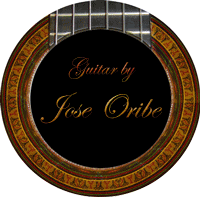 |
Byron only plays Jose Oribe guitars in concert by preferrence, not by contract, concession or special arrangement. Tomingas has stated: “Oribe guitars are the Holy Grail of the Luthier’s craft, living, breathing creatures with gorgeous personalities”. |
|
|
|
| Return to Top
|
My Oribe Guitar by Byron Tomingas (a typical Tomingas long winded account) |
|
When I finally saw the light and went to a serious music school to learn what it was that had enchanted me from birth, I arrived in downtown Los Angeles California from a small town in Wyoming which was quite a culture shock. I now say that Southern California is a great place to go learn things. Unfortunately, you also learn a lot of things you really didn’t want to know; still I wouldn’t exchange that growing experience. There were great talents that befriended me and we were all caught up in the heady excitement of rapid progress in skill, knowledge and testing the power of being able to change the world with our ideas and actions. |
|
| For
the previous five years I had taught myself how to play mostly with a
phonograph where I would put the record on, hear the first note, stop it and
try to find that note on the guitar and so on. From that starting point wonderful
Stippy Wolf and kind Marc Schupman provided some framework for all of these
notes. During my sophomore year
at High School I created the first Rock and Roll band (Teton Rocks) in
Jackson Hole Wyoming and Grand Teton National Park. I had to teach myself all the other
instruments and all the parts to each song so I could then teach others to
play. We played exuberant songs
had such fun and a good deal of fright but the experiences remain as the
highlight of our youth.
|
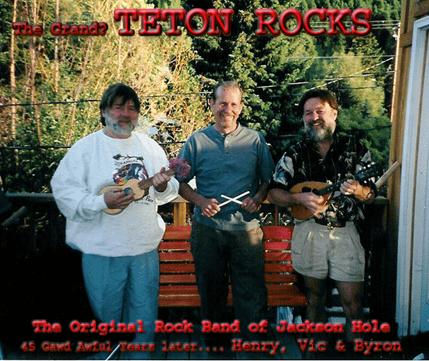 |
| Return to Top | The original Jackson Hole Rock
Band Reunion in 2000 |
The Bad Boy Saunter Video |
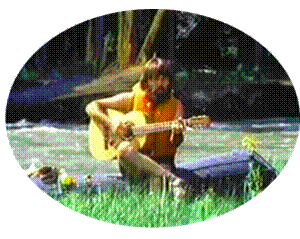 |
When this kid from a town of 1000 in Wyoming arrived in downtown Los Angeles at California
Institute of the Arts, more of a collection of schools such as;
Music, Theater, Dance, Film and Fine Art, I could play Chet Atkins style
renderings of several songs, including the one I auditioned with,
“Yesterday” by Lennon & McCartney. They were not impressed as I
couldn’t read music and knew nothing about theory, music history and certainly
couldn’t play a note of classical music and I was duly mortified and
humbled, I’ve always been a little sensitive, well okay, a lot
sensitive.
|
| Return to Top | |
However as they were a brand new college and desperate to add more bodies to the student body they let me in on probation. There I was suddenly thrust into the brilliant world of “world class” guitars, Oribe’s, Hauser’s, Ramirez, something from most of the greats and a lot of middle greats were there rendering gorgeous music. Being a poverty-stricken boy from a small town in Wyoming and no experience, I had a $12 guitar I had hurriedly bought in Tijuana Mexico. Oh, and what I had to do, was agony, I didn’t get to touch my left hand to the neck for two weeks. Can you imagine hitting a single note excruciatingly slowly for ten hours a day? That’s truly what I did but worse, with a towel wrapped around the neck as the neighbors were being driven out of their skulls with my incessant “ding, ding, ding”. |
I had always played a lot, 5 hours was a minimum, not because I felt compelled to, but simply because I enjoyed the act of making music and inventing new combinations. Beautifully shaped sensual notes contrasted with high-energy exuberance, I come alive when rendering those moments. My first guitar had been a steel string and I did indeed make my finger tips bleed with that one and often had a bandage on the end of my middle finger. Prior to going to a music college, the longest I ever sat was 17 hours just dreaming away with my guitar, and I fell asleep playing as I often did, I just had to try one more thing. Unfortunately, I don’t have that passion about playing in public, it’s a lot of fun to get others excited about the music but not what I live for, I tend to hide out instead probably a side effect from the overly sensitive side of me. In truth, I would rather not be noticed at all, but that’s not an option in the field I’m in, so the end result is that it’s hard to get me out there. I have the same passion about long walks in the mountains with my pups; I revel in high alpine meadows and I just have to see what’s over that ridge or around that knoll, I often have walk back miles in the dark. The smooth elegance of Figure skating also gives me that thrill that takes you to a place beyond mortal existence and I always ache to skate just a little longer to get one more perfectly smooth, turn. Truly though, the only comparison with making music is a passionate partner who adores you, unfortunately they can be a bit more demanding and troublesome than mountains or a guitar. |
| Return to Top |
| Two guitars at college particularly enchanted me, one was a Red Wood topped Oribe guitar that sounded like it was absolutely a living, breathing creature and was the closest thing to absolute perfection I have ever seen. The Oribe’s bargain price at the time of $1000 was of course astronomically beyond my means, the $12 dollars I spent on the Mexican guitar meant I literally didn’t eat for a week. The other great guitar was a Ramirez Flamenco guitar with wooden tuning pegs but the instrument never interested me, it was the pegs. |
| Return to Top |
| What I wanted was an Oribe with wooden tuning pegs but he didn’t make those, or so I thought. But every night I would wrap that awful towel around my poor little Mexican guitar and I would set to it. To give me inspiration, I began imagining, and I have always had a vivid imagination, that it was a Red Wood topped Oribe guitar with wooden tuning pegs and so I would sit every day for ten hours, “ding, ding, ding. It's no wonder I went a little mad in those years.”. | 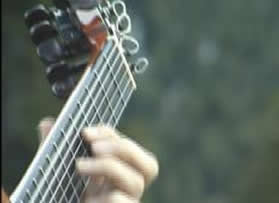 |
|
I tried to tell my friends they
weren’t seeing the real me that I was a little out to lunch until I got
this thing under control but I doubt that any of them had a clue nor cared (he was who he was) what I was
talking about. That was all happening in 1968 and guess what Oribe was
constructing at that very moment? My guitar, precisely the way I was imagining it, of course I
didn’t know that at the time.
|
|
| Many of my fellow guitarists had Oribe’s by then but not me. One of my good friends, a wonderful guitarist Morris Mizrahi had one and deserved it as he could play concerts with vigor and panache. | |
| It was always a treat to ask Morrie what he was working on, his enthusiasm was infectious and he would whip out his Oribe where ever we were, a hallway, restaurant, street or staircase and within a few notes of say something like “Danza Pomposa” you were captivated by the magic of the music and enthusiasm, what inspirational fun. He had been a serious Flamenco guitarist and lived in the caves of Spain with the Gypsies for five years to learn it; he had an indulgent personality and would completely engross himself in whatever inspired him. | |
| Return to Top | Jump to the Tomingas Composition "Mizrahi Composite" |
| Last year I heard that Morrie doesn’t exist anymore, and that loss is sadder because he loved playing magical music for audiences where they would stand up and cheer “Bravo”. Morrie and I were probably the worst sight readers out of all 25 guitar majors at Cal-Arts and certainly not the most cherished by the establishment as we ran wide of accepted classical standards but interestingly, even though we had radically differing personalities, we seemed to be the only two who could actually play a concert and pull it off, the others seemed to freeze up and fall apart and not to be uncharitable, the truth is they just couldn’t seem to get much more than a lot of thumps, bumps and rattles out of their instrument. Maybe they just didn’t have the mortifying fear of falling on your face in front of anyone as I do or Morrie’s unbinding confidence. I really put forth a lot of prior effort in the panic stricken hopes of ensuring reasonable success, getting up in front of an audience is a scary business; I generally consider that I played at a good concert to about 60% of my ability. One of the better sight-readers that was an utter disaster on stage grumblingly said to me after my first concert “There’s more to it than just playing the right notes”. My retort was that you have to hear the notes before you can hear an interpretation. I had a little better guitar in the second year but it was still only a $100 dollar instrument and pretty thick sounding and I was still envisioning my absolutely perfect, beautiful, vibrant Oribe that I didn’t know he had already completed ---- and had already sold to someone else. | |
| Return to Top |
| My Junior year a lot of old fiends such as wonderfully talented vocal major Hal-James Pederson had dropped out, but in Hal’s case he had won a part in the tremendously successful play “You’re a Good Man Charlie Brown” as Schroeder which set his career running. Others had hit pop records and started touring but none of the guitar majors (except Morrie) did anything significant in the concert field and slowly they seem to drift away. So many talented friends had such near misses with fame and success, yes, even me. Out of the group of 25 Guitar majors that started, I think Morrie and I one of the very few to receive a Bachelor’s in Music Performance. People often asked about my cheap guitar and I would say such nonsense as “I’m not getting an Oribe until I deserve it” and they would say “when will that be” and I would say “when I play the Concerto in D Major by Vivaldi with an orchestra”. Oribe’s price had doubled by then but he probably wasn’t making more than 75 cents an hour for the time and effort he put into them. Everyone who knew of Oribe guitars spoke in reverent tones and those lucky few who could afford them considered them Holy Relics that had to be obtained by a trial of fire by going to Oribe’s shop, meeting him in person and being worthy. He was famous for losing his temper and chasing people out of his shop if they didn’t show proper respect or care in handling them and quite frankly he was right to do so, Oribe creates miracles, you either hear and see it or you don’t. |
| Return to Top |
| Then one day in my Junior year I had a friend, Jesus who was an Art major, sweetest most innocent guy in the world and trying so hard to be perfect at everything including body building and guitar playing and oh how the women loved him and he in turn loved them. His art renderings were all highly regarded but they were all of macabre scenes, who knows what goes on in a person. Jesus tried hard, maybe too hard his playing was pretty stiff as if he was weight lifting his fingers in both directions but Art was his thing and music was a hobby and he was very good at guitar as a hobby and could hold his own with many professional guitarists. Anyway, he excitedly dragged in a beat up old guitar case that looked like a ragged grey silk pin striped suit twisted sideways that someone from Bulgaria would wear if they were trying to stylishly standout in the 1940’s and it looked very weird on a guitar case. He said “Look what I’m buying from a friend of mine, he doesn’t care about it, he just buys a guitar for awhile and then sells it and gets some other guitar” he opened the case and there it was, my beloved Oribe. I was standing there stupefied thinking, “What’s my guitar doing in that ugly case?” I could not come to terms with the fact I was actually seeing my beautiful guitar and that it was in someone else’s arms. Jesus jerked the guitar out; its perfect body had dings and signs of neglect. “Do you want to play it? You can borrow it for awhile if you want.” I was ready to play it forever, as I played, it spoke to me with hauntingly sensual tones and beautiful balance, the epitome of grace and elegance, my perfect, oh so cherished for so many years Oribe, now in my arms. In fact I played it for the rest of that year and then I had to make the ultimate devastating sacrifice, I had to give it back when I went home for summer and go back to playing my thick guitar. I was mortified. |
| Return to Top |
| I was back for my Senior year for a month or so when I ran into Jesus again and asked him if he had bought my Oribe guitar. He said, “Oh, I’ve changed my mind, I’ve been loaning it out to my students, there’s a new guitar maker that’s making one just for me”. I thought my friend and the guy who owned my guitar must be absolutely deaf and blind not to see the glory in this instrument. So, probably with a shaking voice, I asked if I could buy the Oribe and over a nerve wracking 12 days he finally checked with the owner and the deal was done for far less than a new Oribe, but I still had to somehow raise the seemingly enormous funds which was made more difficult as the price of the college kept going up each year and I wasn’t making any more money than before. My original music was supposed to be on the Blood Sweat & Tears concert, the Tom Jones TV show, a movie with Cher and Michael Douglas the actor had just finished a movie about a guitar player that was supposed to have lots of my little miscellanious guitar things on and not one of those things came through. I played in pop bands with bass or guitar and taught in LA to supplement my summer earnings but things were definitely tight. My senior recital was coming up and I was practicing hard for that, I had completed a transcription for Guitar and Harpsichord and I also played the Bach Bouree of course and then just two days before my recital I paid for my Oribe guitar walked on stage and played as the finale at the concert, the Vivaldi Concerto in D Major with a string orchestra with my Oribe guitar and my heart, soul and beautiful guitar sang together in public for the first time. |
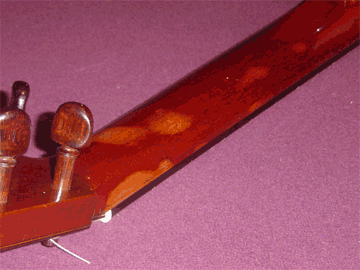 |
And then door on my college days closed and my Oribe guitar and I were on our own. We came to know each other well over the years; the emotional levels we’ve reached are numerous beyond count and well beyond descriptive words. | ||
| Return to Top | Addendum 2007: | ||
Jose Oribe & Byron Tomingas
2007
Photo by Juanita Oribe
|
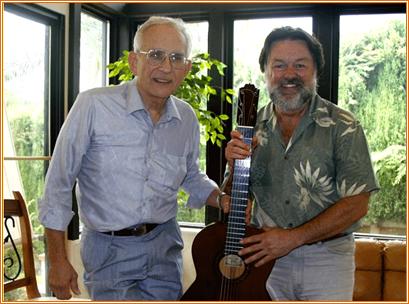 |
| After many years of very serious playing,
it was time to return my beloved Oribe to the Master Maker for checkup. I also wanted to present Oribe with
the composition I had written in honor of my cherished guitar, the Oribe Fandango. So I went
to the Maker and he showed me three miracles. Impossible as it might be, he raised
the bar several notches and has produced such brilliance that it literally
took my breath away, I had to stop, take a few breaths and pretty soon,
instead of playing to show off my ability or the grace of some composition, I
was rolling through a simple chord and breathlessly listening in awe to such
beautifully matched tones that seemed to resonate forever, then one or two
single notes in the upper registers which set all the overtones ringing as if
struck by the Angel of perfection, captivatingly beautiful. So, if you hear one of my concerts
today it will be with my Grand Concert Oribe, which has already been described
by one listener as sounding more like the finest of Grand Pianos. The
abundance of sheer of volume not only echoes off the back wall of the concert
halls I’ve played but equally off the side walls, so the range of
dynamics is incredible and oh, the sweet quiet notes, it hurts your heart to hear
such innocent beauty.
|
|
| Now, I’m a very sentimental sort of guy, so what about my cherished Red Wood Flamenco? Oribe performed yet another miracle and took my well-worn guitar and brought it back to absolutely new condition, something I didn’t get to enjoy as I bought it used. Now, when I want a warm, quiet contemplative nostalgic moment, my Red Wood is back in my arms as we stroll through the beauty that music can weave, now it's a musical familiy sharing the bloodline and life force together. And as it is just like new and better, it’s like being in a time machine, and getting my dream guitar all over again but this time, but now as the first owner, so it’s saved for those special, personal moments in pristine condition at last. | |
| Return to Top
|
|
| Return to Top |
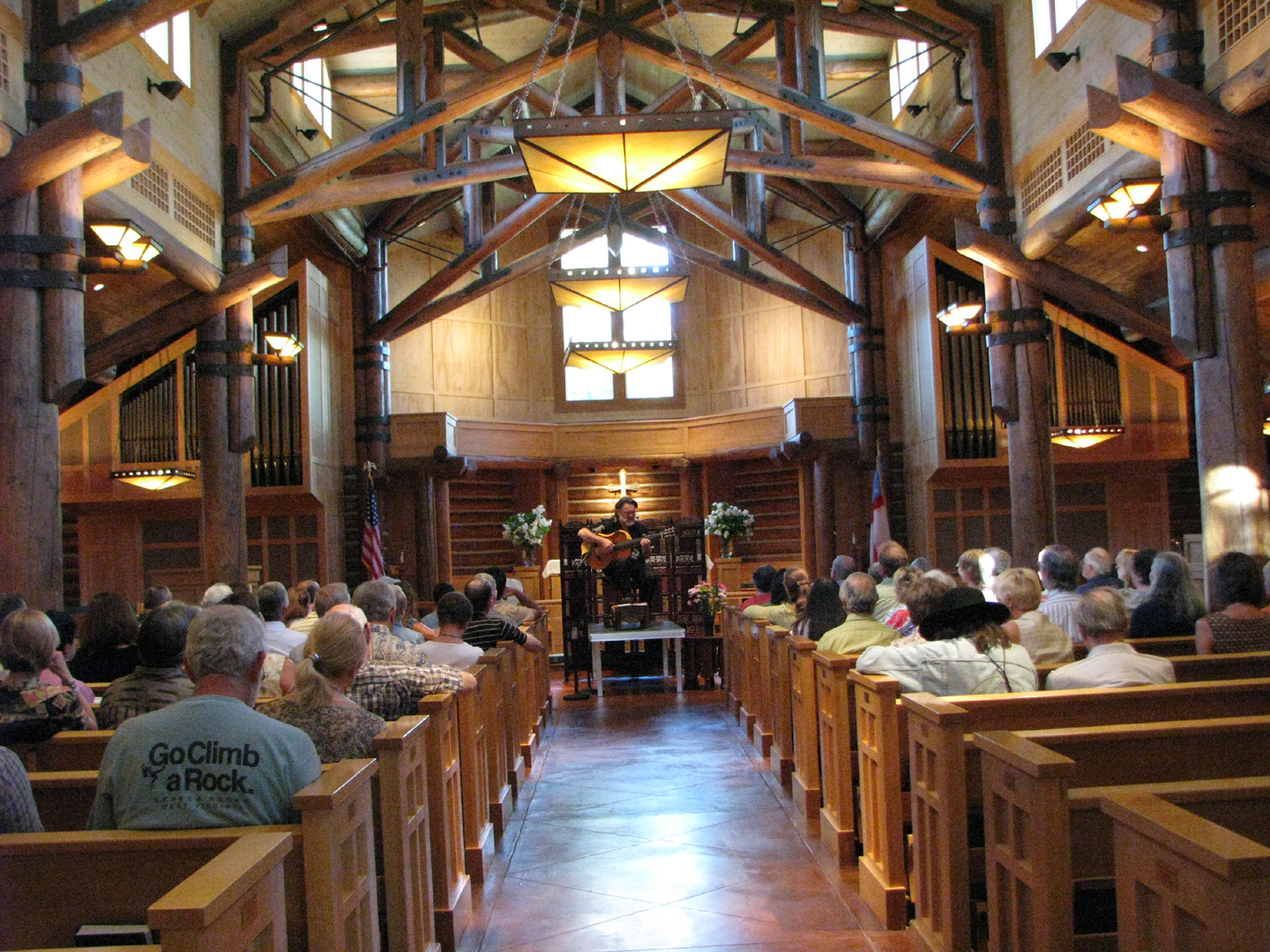 |
|
On my birthday, June 28th I gave a free concert as a thank you to all those who share their musical enthusiasm with this kid. Many of them are gone, but not for me, I still hear Stippy's mischeif in my music, nearly every chord I play makes me think of kind Marc Schupman who taught me the single most import facet of guitar understanding, how chords work up and down the neck. When I enjoy a symphonic work I always think of the Schulers who took me to my first classical concert at Grand Teton Lodge and how they loved music. When I get up in front of people I always think of gentle Ellie Sines who believed in me when I was just beginning in this field. |
|
There were also all the terrific professional performers Dave Yeary, Bernie Waters, Bill Choat, Rusty Draper, Ellie Sines and so many others who would play at the Wort Hotel and I would stand just outside the bar in the lobby when I was about 14 and listen all night. |
| Return to Top |
."Byron's Birthday Concert" Program Notes: |
|
|
For my Dad and my oldest Brother Robby
I was fortunate; I was raised in a family that loved music making. One of my fondest moments as a child, was to see my father get together with his brothers. These uniquely talented men who were normally, very quiet, very polite, enormously intelligent but difficult to know as they were so reserved, would suddenly transform with instruments in their hands, coming alive with shouts of laughter and uproar, yelling “Let’s shoot another tune!” and they would launch into “Turkey in the Straw” or some other Tomingas favorite like “Redwing”. All four of them were close enough in age so they had a Barn Dance Band in Gillette WY with fiddles, guitars, banjo’s and mandolin’s when they were still teens, in their later years, they had reunions and made uproarious music into the wee hours.
My Mom went to school here and sang in a girls quartet, wonderful “Boogie Woogie Bugle Boy” sort of things. She has a beautiful singing voice and I always loved the days she would be humming little parts of songs.
My brother Henry would play guitar and our oldest brother Robby would play Mandolin and they won lots of contests playing “Under the Double Eagle” as Robby could really fly double picking. In fact, it was Robby that was the musical prodigy, certainly not me, my brother Henry was the creative one, I was so shy that even today you can’t get me out very often; Robby was easily the best of us all. Robby’s main instrument was Trumpet, he could triple tongue at 10 years old and played “Buglers Holiday” as one of the soloists with the High School band when he was only eleven. I still see him playing on the gymnasium floor with the band and can hear the song as clearly as if I had just heard it a minute ago. However, Robbie’s life and dreams of having a band like Harry James was not to be, two years before the Polio vaccine came out, Robby succumbed to the terrible thing that it was. My family was devastated; he was only 12 years old. Music became so painful to everyone that pretty soon all the instruments left the house and music simply stopped. Years later, my brother Henry came to the rescue.
Redwing is for my Dad and his brothers’ musical adventures and it is merged with the great marching song, Stars and Stripes which always reminds’ me of my oldest brother Robby and how he could fly musically. |
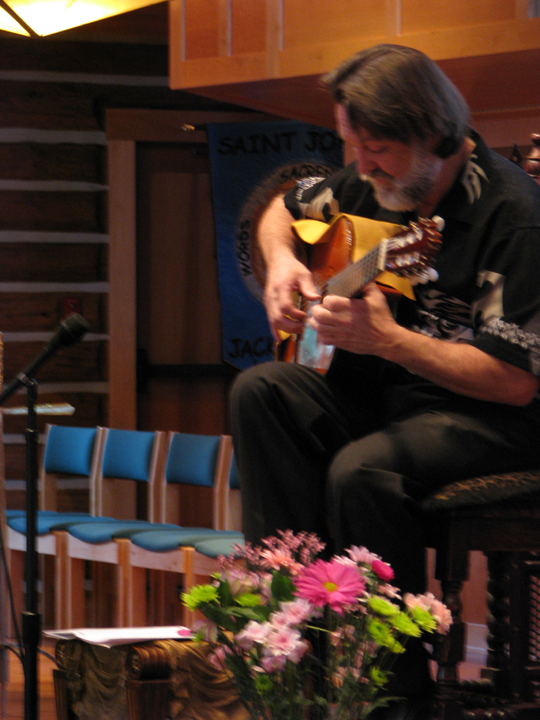 |
| Return to Top | |
|
For Marc Schupman, guitarist & good guy
This composition was written for a documentary film that went on to win awards and has become required viewing at all California schools. It was called the Bountiful Harvest of Steinbeck Country and tracked the growing and delivery of all the food grown in the Salinas Valley. The work uses some of the knowledge of chords that I learned from Marc Schupman as does nearly every song I arrange or compose.
When I first started playing guitar, my Mom arranged for guitar lessons from Marc Schupman. I used to carry my guitar (no case) down the road to Marc’s house all one winter and then he would try to find something to teach me. I was not a very good student, I wanted to play that new thing called “Rock n Roll”, Marc played Country music which I didn’t have any interest in, that was adult music. But he still wound up teaching me the single most valuable thing I ever learned in guitar, how chords work. He showed me that all Barre Chords were simply the first position chords slid up the neck and re-fingered to cover the open strings. It was a revelation, but I was so shy and retiring that I’m certain he never knew what a big deal this was to me but it was a major milestone. From then on, every single note riff I would learn, I would try to turn it into complete chord transitions.
I remember my brother and I talking in awe about Marc and what a great guitar player was, how he knew exactly which string his pick was on at every moment. Marc was a young man at the time, his children were very young, he was handsome, very athletic with a build that body builder would envy, a terrific quick smile and an incredible amount of energy and enthusiasm. I still remember him clearly sitting in his small office with a Fender Piggy Back amplifier, a Chet Atkins Gretch guitar, one of the red ones. I looked at that whole setup, it was perfect, even though he had married very young, he had created through hard work and great dedication a perfect situation and there was no doubt what so ever, he loved his family and loved providing for them and still had the energy to pursue his love of music, it was an admirable accomplishment by a wonderful guy.
|
|
| Return to Top | |
BULLDOG & HONKY TONK For my brother Henry who brought the music back to us My brother Henry is 6 years older and when he went to college he came home with a guitar. He had a roommate Tucker Smith who is now a famous artist but Tucker was also a terrific guitar player and my brother got interested in playing again. Folk music was in full swing with the Kingston Trio, Limelighters and Peter, Paul & Mary. My brother had also been concerned because I wasn’t interested in anything, didn’t want to be seen, I was withdrawing, I had always had my dog to hang out with but when I was 14, his time came and he died. So my brother started gathering up our loaned out instruments and came up with even more, including “Electric Guitars”. Even my Dad got interested again, and my Mom started trying to help me pursue this interest. As I had always loved music, I guess it was natural enough that it finally took hold, maybe too much, most days I played at least five hours and often it stretched to ten, simply because I wanted to try doing it this way or that, or smooth this part and fix that part, polish this, find something new, I didn’t know much, but I knew those little bits inside and out.
The songs that were the technical monsters of the day were Bulldog by the Fireballs and Honky Tonk. Honky Tonk was way beyond my brother or me but we could just squeak out a version of Bulldog that was acceptable. My brother would go off to college and I would stay home and practice so pretty soon we switched around whom got to play the leads. He kept after me to start a band and so finally I did. Vic Lindeburg was my friend so he became the drummer, but I needed a rhythm guitarist so my brother’s plan turned around on him and he had to also stand up in front of everybody and try to play these songs whenever he was in town, scared all three of us to death but everybody seemed to really like our songs. My brother is famous for being the first to run the Snake River Canyon and first to commercially float it; Kahuna, Champagne and Lunch Counter belong to Henry and bear the names he gave them. But more important to me, my brother is famous for bringing music back into our family. The photo is the “Teton Rocks” 40 years later: Henry, Vic & Byron |
|
| Return to Top | |
SWEET GEORGIA BROWN Dedicated to Stippy Wolff |
In the 1940’s, when my Dad and Mom were first married, riding a blue Indian motorcycle with a slick sidecar and raising my two older brothers, they lived and worked at the Elk Ranch near the upper entrance to Grand Teton National Park. One of their neighbors and close friends was Stippy Wolff, guitarist & fiddle player. |
photo of Stippy courtesy of Greg Keckler, Cowboy singer/guitarist |
|
When I was born, my parents moved into the town of Jackson, in fact I was born on the very spot where this concert is being held, June 28th at 6:30 pm. The magnificent 3 story log building that was the old St. John’s Hospital used to stand on this same piece of property so it is a great privilege to be able to give a concert here and open the many musical presents that have been given to me by wonderful people who had passion for music and were kind enough to share it with me. I remember many times when Stippy would come to town and bring his guitar, huge grin and boundless enthusiasm. I think he is the only person that loved “making” music and teasing with it as much as I do. He would pull out his guitar, look at me and say “Are ya Red-Eye?” (“ready”, he teased with both words and music) and then we would tear into Sweet Georgia Brown. I really struggled trying to keep up on all those chords as he would fly through this difficult song. I would like to think that the fun in my music was greatly influenced by wonderful Stippy Wolff |
|
| Return to Top | |
|
Dedicated to Dick Barker,
This is one of the most impressive compositions ever placed on a guitar. Like Greensleeves, it was crafted by many gifted hands. One of the best versions was by the great Flamenco master Sabicas; you can find a video of him playing this on the Internet. His version is considered the definitive standard for guitar. Many other people have played and recorded this song but it’s hard to best Sabicas, usually it’s greatly simplified by comparison, elements are left out that were too difficult or obscure, however the song is so strong that it still stirs people into a frenzy even in its simplest form. When I was growing up in the small 1000 person town of Jackson Wyoming, there were a few good guitarists around like Karle Johnson and Ray Weeks, however they usually played Country and Western; I being in my early teens was into Rock ‘n’ Roll and Chet Atkins style of guitar playing. There was one fellow though who played something different, lots of finger picking and on an acoustic guitar, not a F hole archtop cowboy guitar like everyone else played (including me). I recall that the rhythm guitarist in my Rock band heard him accompany a girl singer with his fancy finger picking and said it was the most beautiful thing he had ever heard. My mom signed me up for some “finger-picking” banjo lessons at his music shop but he was about to change professions and become one of the most successful river trip operators in Jackson so we bartered for some new strings instead. However, this “finger picking” guitarist also did a version of Malaguena and stirred the hearts and imaginations of all who heard him play it as he now does today with his story songs at the Hootenanny. His son told me one the things that he most admired his Dad for was Malaguena. So, I’m doing this song as one of the musical presents I, and many other people in Jackson, got from Dick Barker. Now in most songs, the trebles normally get all the good solo’s and glory; the basses are usually confined to support the melody rather than getting to play with it. But, in my version of this song, the basses are fed up with the arrogant trebles and won’t play second fiddle anymore. |
|
The trebles demonstrate their ability first in the most recognizable part of the song, suddenly the basses jump in and do a version, the trebles then rise to the challenge and add more tricky elements, a two finger tremolo, into the theme. The basses in their turn match the addition and show how effective they can play it an octave lower. The trebles start to tremble and move the competition up another knotch by adding a three finger tremolo to the solo plus a few “hammer/pull off” slurs finishing with harmonics. The basses however respond with a duple arpeggio and flourish with harmonics to end this round of the competition. We then turn to the other major theme of the song, at the end of which, the trebles come up with a new rendering of the theme in the high registers. The basses seem to stall around, are they defeated or maybe it’s just a tease before the grand slam….. dare I say - “stay tuned”….. ouch. Interestingly, at least to me, I never really learned this song, there’s a couple of these compositions like the Spanish Romance, or Greensleeves that I never spent any time on in the normal sense of learning them but somehow through their popularity and familiarity I seem to be able to assemble all the bits and pieces that make them up. For this concert however, I have experimented with the work and found a couple of new ideas that I hope you will enjoy. The Malaguena is from Malaga Spain and is one of the dances from that region; this version is loosely based on the composition by Alexander Lecuona. If you ever hear a Piano version of this work, you might notice a high emotional similarity with Franz Liszt Hungarian Rhapsody #2 or the Paganini Variations. |
|
That's Dick & Barbara Barker on the far left...... |
|
| Return to Top | |
WALK DON'T RUN For all of my Band Pals; Henry Tomingas, Vic Lindeburg, Jim Moran, Bob Steen, Dennis Green, Pat Woodward, Riley Wise, Bob Weber, Ding, Art Thayer and many more that popped in and out.... My generation was a tween, we were between the Everly Brothers and the Beatles. The Ventures played instrumental, electric, Rock and Roll and that’s what my band was modeled after. The song I most admired at the time was “Walk Don’t Run” the Johnny Smith Jazz tune but as played by the Ventures, Rock style. The music came from 78 & 45 RPM records, I would put the phonograph needle on, listen for the first note or the next note and then take the needle off and start looking for it on my guitar while holding that note in my head, I spent enormous amounts of time doing this and by doing so, learned many Chet Atkins arrangements, all the parts, bass, drums, rhythm leads, to all of the Rock songs my band played. Small tape recorders, walkmans, cell phones, computers, effect boxes, none of that existed then, we didn’t even have black and white television in this valley until I was in High School. And yet, in the time honored tradition of generations, we were the new kids on the block, and rapidly pushing the older generation aside and then it was our turn.
Every night I would take my portable radio downstairs to bed, it was the beginning of the high tech marvels of our generation, it had the newly invented transistors and ran on small batteries rather than having to be plugged in, and that was a revelation. And, it picked up the only Rock station we could get in mountainous Jackson Hole, small town of 1000 people, KOMA in Oklahoma City, but only after they boosted their signal to 50,000 watts between 8pm and midnight. Wipe Out, Apache, Sleep Walk, my generation, my songs. The Roaring Reddogs band always advertised where they were playing, I thought, “Boy, that’s cool, it would be the tops to be on KOMA”. My transistor radio can still bring in KOMA today, that’s quite a lifespan. My pal Vic Lindeburg offered to learn drums, I had joined the High School Band as a percussionist to learn to read music and how to play drums. Kind hearted Dave Yeary who had been famous twice as a singer had an old snare drum he donated to our cause, Clay Taylor brought over two copper colored sparkle flake true electric guitars and a huge Silvertone Piggy Back amplifier, but for all of its impressive size, it had almost no volume as the tubes were all worn out and needed replacing. I found a bass drum foot pedal & broken cymbal in the school band junk pile and then arranged to borrow the drums I didn’t have, Louie Dopyera of Dobro Resonator fame summered in Jackson and heard of my interest and gave me a guitar pickup and some other parts and finally, there was enough for the first band. My brother now says “be careful of what you want, because you might get it.” He got that from pushing me, saying that I ought to go play at the Church dances, it backfired on him. After I set an event up he realized, he had to play rhythm guitar in front of all those people. Although he felt better about it when Vic and I collided together as I remembered I needed an extension chord and whipped around and he was following right behind at a run. |
|
We played Wipe Out, Sleep Walk and Bulldog. We had to repeat because our audience of teens had never heard a live Rock band before and they actually liked it! My brother went off to college and a new guy from Montana joined, Jim Moran, then he left, we had some other people along the way but then Bob Steen and Dennis Green stayed, but then Vic got called to duty in Vietnam, so Bob Weber joined us. This group was together the longest and played everywhere, including Pinedale, Dubois, and quite often here at the Episcopal Church, they had modern buildings on this site at that time. Then Weber got the military service call and I located someone we called Ding from Rock River, WY, then Art Thayer from Riverton joined and we became the Fabulous Fugitives. One of the essential people that should have been a member was Karl Linquist, he owned the electronics shop and every Friday afternoon as we setup to play a dance, some capacitor or something would blow out and I would cut out the blackest parts and run down there and he would try to figure a replacement part that would work, I would go back and solder it in. That amplifier still works perfectly today! *We would call a Police department in some town to find out who had a hall where we could hold a dance. We always tried to talk Bob Steen into handling that part as he was a businessman even when he was sophomore in High School, looked the part, talked the part, that was what he was going to do and indeed did! He would start off with something like “Well, I’ve got these boys that put on a good show….” We would put up a damage bond, hire a policeman or two, put up ads on the local radio stations and try to find someone to put up posters. And even with that hodgepodge method, we never failed to have capacity crowds. Big Dave Edmiston was a favorite ticket taker/bouncer, he was good guy that we could trust and nobody in their right mind would ever tackle him. We went to Denver to make our fame and fortune and through a significantly hilarious series of disasters we managed to nearly starve to death, barely stave off a gang rumble, police arrests, epileptic fits of our new drummer, we looked and acted too conservative and while our music was thrilling, we were in a state of total embarrassment as we had junk equipment that I mostly built from old Jukeboxes and light shows with old switches and tape, the bands we were competing with were using the biggest and best equipment, we looked like hicks from the sticks and we knew it. So after a month we limped home. However, we played all over Wyoming and it was always capacity crowds and they seemed to love us and wondered why we weren’t in California making our fame and fortune. The band was tight and could do new songs on the spot, we had choreography organized so we could choose different cool dance step combinations with each song; we started at 8 sharp and played steady with only one fifteen minute break until midnight and did not repeat a song. We didn’t know it when our last dance came; it was a huge crowd in a huge auditorium, we sounded great, girls were taking our autographs, and to top it all, while driving to play the event, we even heard the ad I placed on KOMA radio at 50,000 watts “the Fabulous Fugitives are playing in Riverton, WY” and at the end of the night, we all went our separate ways and on to our lives that were to be. |
|
MIZRAHI COMPOSITE by Tomingas For MORRIS MIZRAHI, a Passionate Guitarist My degree is from California Institute of the Arts, an interesting concept as a college. A creative personage no less than Walt Disney envisioned a campus that embraced all the arts, where they could mingle and share creative treasures. So he built a new college which was on an exciting, uncharted adventure, they hired the top performers as teachers and it attracted an odd collection of students with extreme personality spikes in several directions such as brilliantly talented in creative arts and socially inept. But the mix of so much new adventure and brilliant minds created a heady atmosphere for those of us making leaps and bound in knowledge and ability. There was one that certainly stood out from the crowd, he showed up with a Ramirez Flamenco guitar and had lived in the caves of Spain with the Gypsies for five years learning how to play it. He was now fully engaged in being a great classical guitar performer, the infectious passion and enthusiasm he had for his instrument was magnetic. The first thing I heard him play was Flamenco; I had never heard that style before with its wild dissonant tension and exuberance mixed with Oriental scales, and great passion. This was a completely new sound for me. Whenever we saw each other, the first words were “what are you working on?” We didn’t even greet each other, it was so much fun to see and share the latest musical adventure. We could be in a hallway, a staircase or a street corner or a restaurant, and Morrie would whip out his guitar and play as much he could of some new song, say Danza Pomposa, then I would play as much as I had of something like the Bourree in E minor by Bach, and in doing so we recharged our energies and would put even more passion into our playing. I can still vividly see his stubby but very capable fingers playing Danza Pomposa and the sustained scale run in A minor which he shared and I use in several songs today. We also had great conversations about the String Quartets of Schuman, Brahms and Beethoven plus the latest Beatles tunes, the movie 2001, Jobim and in reverent tones about the holy grail of concert guitars, the Oribe. |
|
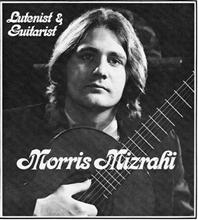 |
Morrie and I played a lot of solo concerts individually at Cal-Arts but only once played a guitar quartet together. It was a very odd piece, very modern, made up of rules as the four of us looked it over, I noticed that the composer had made a set of rules to say you can do whatever you want, well I said it was an odd piece and very modern. It was called “On the Bus”, so Morrie, who by then had sold his Ramirez and bought a concert Oribe guitar, decided to be the driver of the bus and with his tongue firmly in his cheek, he simply held his guitar and never played a note. I chose to randomly hammer away at the fret board with both hands like a piano, as I said previously about odd…. |
In any case, Morrie and I had a good time “playing” in front of audiences but that was the only one we got to do something together. Most of the time when we were doing ensemble concerts, we were paired with players who struggled in front of an audience, Morrie and I were terrible sight readers but we could always be relied on to get the notes out when it counted. While we were completely different personalities, we both still ran equally wide of accepted standards of background (I was a Rocker and he a Flamenco player) and acceptance of musical rules except when it came to putting on a solid classical concert, and there we both excelled. Then Morrie and I graduated and the door closed on that era. I moved to Monterey CA and Morrie to Malibu CA and we both started pursuing our career. A few years later, he played a concert in Santa Cruz which was nearby, so I went and saw that, and just as we knew he could, the audience found his emotion and passion for the music and rose to a wonderful standing ovation with shouts of Bravo, we had a good time reminiscing. Then nothing, years past and I didn’t hear of him and started wondering what happened. Last year I went to see my guitar maker Jose Oribe and happened to ask about Morrie as Morrie was every bit as enthusiastic about Oribe guitars as I. Oribe told me that Morrie didn’t exist anymore, while it was sad for me, I felt even worse for all those people who would have loved to hear Morrie play with panache and enthusiasm, all of us lost a great musical treasure when Morrie died. So, I wrote this song or rather composite for my friend. I called it a composite because it has cameo appearances of some of the compositions Morrie and I worked on at college and other influences of the time. They pop in every now and then wrapped in the style of what I heard Morrie play first, Flamenco. Now, I don’t play true Flamenco, (never lived in the caves of Spain) but my hands know some of the techniques and I’m familiar with the rhythms so the effect is similar as it provides the base around which the little excerpts of other songs and studies appear. It has an ad lib nature and is therefore different every time it’s played which makes it a little dangerous to perform, Morrie would like that. People should know about this special person that lived life with gusto and passion, the music world is certainly not as vibrant as it could be if Morrie was still playing his Oribe. My playing shows influences of my friend Morris Mizrahi, an extraordinary guitarist. |
|
| Return to Top | |
Canarios Arranged for the modern guitar by Tomingas
Canarios refers to the Canary Islands off of Spain. Gaspar Sanz wrote this in about the mid 1600's for the much smaller instrument of the day, the Vihuella. (See a picture of a Vihuella by Stradivari) I dedicated this to the Schulers who were kind enough to take this kid to my first symphonic concert at Jackson Lake Lodge. I remember George getting so excited and bouncing around at one magnificent moment in the concert, he leaned over and whispered "I just love that part". For me it was such a huge torent of sound that it flooded my senses and I couldn't grasp anything. I remember thinking "I hope I can someday catch the flow of this music like George" |
|
‘ Twas a dark and stormy day, February in Jackson Hole, the height of winter was upon us with hazardous weather advisories, closed roads and airports, low visibility, cold weather and a blizzard blowing. And yet, they came, the lovely Concert Hall filled up with enthusiasts who tolerated a half hour delay, a long concert of over an hour and a half and still they cheered, applauded, whistled with shouts of bravo while standing and calling for an ovation. This turns out to be my debut return to the concert stage after a decade and a half as well as the debut of my new Grand Concert Oribe. The event was in a perfect concert hall with wonderful people who loved music making this the most satisfying and enjoyable concerts of my entire career. |
|
| More video's by Byron Tomingas | |
| Return to Top | |
| A few of the kind and very appreciated comments and reviews received about this concert: | |
· "The emotion you put into your playing/composition shines through your brilliant fretwork" Max Ludington, Bluegrass Bandits
|
·
“Magical
fingers and extraordinary talent” Ralph L.
San Diego, CA
|
·
"Tears
were in my eyes during the Shostakovich Romance" Mary Springer
|
·
"As
an audience member, I was completely wrapped up in your playing" Amber
Hoover
|
·
“A
great concert....those pieces were wonderful” Tom Turiano, Musician
& Author
|
·
“Fantastic”
Mark Memmer, musician
|
·
“a momentous occasion” Nate Edwards, musician
|
·
"I’ve
been awestruck by his undeniable virtuosity time and time again " Aaron
Davis, Musician
|
·
"Boo's
Requiem touched me so deeply" Madeleine M.
|
·
"I
couldn't get up to leave, your music was still playing in my head and in the
room even after everyone left but I just couldn't let it go, I was lost in lost" Amber Hoover
|
·
“That
was the best version of Dark Eyes I have ever heard” Several Attendee's
|
·
“Bravo,
encore” John Kuzloski, Blues musician
|
| Return to Top |
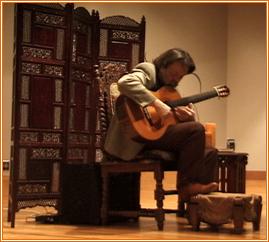 |
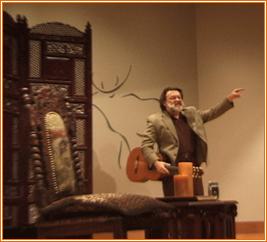 |
| Return to Top | |
Museum Concert Program Notes. |
|
| Dark Eyes
|
|
Arranged by B. P. TomingasDedicated to Grandmother Emma Kinna~Tomingas & my Mom, Hailie Morrison~Tomingas |
 |
Key of A minor
During
the reign of the last Tsar, Emma Matilda Kinna was a very young girl growing
up in Saint Petersburg Russia; she lived near the Hermitage Museum in some
degree of elegance for she was well educated and wore many beautiful dresses. In the winters, Emma and her mother
Tiina would often ice skate on the frozen Neva River. Emma spoke many
languages and could write in several as well, she was a budding
horticulturist and loved to play the organ. There is a mystery about this bit
of history for Emma, her mother and father were Estonian, Russia at that time
despised Estonians and worked very hard to subjugate the little country and
created many Russian laws to restrict Estonian rights and attempted to make
them second class citizens. A few years earlier, Ukrainian poet
Yevhen Hrebinka (1812-1848) composed the poem Oche Chyërnia in St. Petersburg, Russia
after falling in love with some un-named dark-eyed beauty, The poem was later
set to music by an unknown composer, or perhaps it was just new words for an
ancient Russian folk song.
However, the Russian Revolution was on the verge of exploding, so
Tiina’s brothers boldly kidnapped Tiina and Emma from Russia and took
them to Canada. There, life
changed drastically, they lived on a farm with all the hardship that farming
in the cold north can bring. Emma
met another displaced Estonian, a handsome man that she had read about in
underground Estonian newspapers, a leader of Esti freedom fighters with a
Russian price on his head who was nearly captured, wounded in his escape and
hid out in the forest through one entire winter with his cousin. They too, then made their way to
Canada and Jaan met Emma and they married. They built a home for themselves in
Gillette Wyoming and farmed while raising their eight wonderfully gifted
children. The one luxury that
Emma managed to save was an organ that was played by pumping air into it with
pedals. There was a flood one
spring and the entire house floated away, however the organ was again
saved. The organ is still in the
family line.
Emma,
on quiet nights, when chores were done, way out in lonely plains of Wyoming,
would sit down at her organ and play songs of her childhood. Her children became musical as well,
but they went their own way playing modern barn dance music with fiddles,
mandolins, guitars and banjos. When Emma’s children married, one of her
sons’ spouses, Hallie could sing beautifully so in about 1939, Emma
taught Hallie the words to several songs in Russian, the favorite was the
Russian ballad, “Oche Chyërnia”. This
has become one of those beloved songs like Greensleeves that rather than
being crafted by a single person, “evolved” through many loving
hands.
When
I was a very small child there were two songs that touched me deeply and
continue to do so to this day, one was Oche Chyërnia and the other the
Brahms Hungarian Dance number 5. Beyond their elegance and energy, they have a common ground in
accelerating rhythm structures that have always excited me beyond words, add
glorious melodies and simple harmonies, the result is, I am passionate about
these songs and so it has been one of my greatest pleasures to render this
instrumental arrangement of Oche Chyërnia that embodies so much of who I
am, it offers all of the emotions, sensitivity, excitement and lets me take
extreme risks in the hopes of breathing emotion into this moment of time we
all share.
|
|
|
I
would very much like to think that my grandmother Emma Matilda Kinna/Tomingas
would enjoy my arrangement and fortunately I already know that my Mother
Hallie loves this rendering and she still remembers the words in
Russian. So, I now offer it to
you in the hopes you too can be swept into the magical flow of “Oche
Chyërnia” which means of course, “Dark Eyes”.
|
|
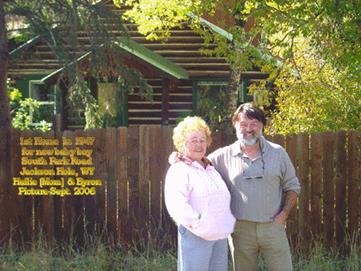 |
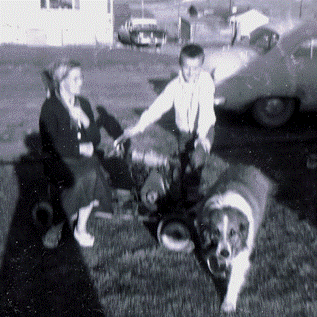 |
| Byron and his mother (about 83 at the time and still able to beat the socks off of Byron at Golf!) in front of the first house in Jackson Byron lived in | Emma
Kinna/Tomingas, her grandson, Byron Tomingas and his spectacular and famous
(via Disney films) dog, Commando, and the wonderful gas powered car built by her son, Byron's
brilliant Dad, Bob Tomingas |
| Return to Top | Tomingas Family History Web Site |
| Boo’s Requiem | |
Composition by B. P. Tomingas
In
the Key of E minor composed mostly during 1995 assembling earlier musical
fragments from 1968-71 and recent “renovations” in 2007
This composition speaks to the journey of life and
loss. Its first percussive notes
are not about the notes struck but the sympathetic ones that resonate
afterward. This life story starts
as a small flicker of light that grows to dazzle and charm, comfort and warm
then the exhilarating passage of time with overflowing joy followed by the
inexorable decline and steadfast march towards the end. An E minor with a suspended 2nd sounds
the toll. The heart shatters and
plays its melody of ache. The
melody loses its way but somehow wandering lost and alone, the melody emerges
at the highest point of the fret board, indeed, right back where after the
long sinuous stream of time had passed, life had begun.
Boo’s Requiem was composed specifically for
my son, a large German Shepherd dog, bi-color named Khyber (Boo), my friend,
the ever watchful, the ever diligent. Khyber (Boo) was a 125 pound giant,
mostly black with yellow eyes, tan forelegs, very capable, very confident,
very dedicated and yet very calm. And when he stood on his back legs he was
taller than me! Khyber was a huge
part of raising my daughter, he was her guardian, her friend, and he taught
decency, honesty, humor, dignity and dedication. When we would go for walks and meet
people, Boo was perfect, friendly yet reserved and inevitably without being
obtrusive, almost by magic, he was always standing between my daughter and
whomever we had met as if it were a completely casual occurrence.
He was my trainer, my confidence, my pride, keeping me on schedule, ensuring that we had our daily hour or two runs, sometimes twice a day often at night in the forest. He was my eyes, my early alert, my right arm, my sensibility. Together we were a very strong team. His loss still hurt me very deeply, just like loosing a loved family member or a part of your body. I still find it difficult to perform this work and rarely perform it in public |
|
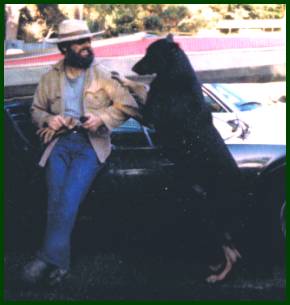 |
|
he was asking to go kayaking with me…. |
|
| Return to Top | |
| The Oribe Fandango | |
Composed by B. P. Tomingas & Oribe68
Key of E, Composed in 2006 in
honor of my cherished 1968 Oribe Flamenco guitar
The story of this composition has more to do with the story of my
wonderful companion of so many years generating magical moments of soaring
emotional journeys. If we could
just play for people what we play privately in the late hours of the evening
when all is calm except the sounds of living, breathing music, ah that would
be the ultimate concert. When the
connection between instrument and musician has been a rich one, with many
years getting to know their joined personality, the touch is comfortable and
confident without reservation, innate. Those personal moments intertwine the
instrument and the musician as though they were a single complex life
force. Each nuance of sound
permeates the entire body of both, firing synapses and resonating areas that
have lain quiet seemingly for decades bringing an emotional richness that is
on such a lofty plane as to be inexplicable with mere words.
One glorious evening of
musical entwinement I was struck by a horrible thought, when I die, my instrument
will continue, but it will never again sing the same songs we sang together
with our emotional phrasing flowing like a strong river, never ever again,
never. Doing what I do, where
emotions are an aspect to be cultivated, I can be a extreme light weight,
tears flowing, hugging my instrument, my dearest emotional friend knowing the
loss is inevitable. A panic
ensues and you are compelled to reach for those rare moments of rapture again
and again, letting the emotions of music have their so short moment of
enchanted life. Creating music is
like making sparks in a very dark place.
So one does what one can using the tools and techniques
they are the most fluid with and can express themselves the best with; so my
guitar and I began on a composition, for my guitar.
Composing
is an interesting study, while it can be very academic, that should just be
the filler, the way to get pass a blockage in the flow, a way to round out
the edges; but for the real music, there is a far more elusive side to it
that creates all the real beauty and originality. But to achieve that elusive
goal, you might as well try to hop a ride on gentle breeze blowing by, the
relationships are so delicate that our clumsy thoughts and bodies stumble
over ourselves and lose sight and scent of the magical flow. Any creative person knows that when
you can rise to the lofty place and ride the flow, you must not under any
circumstance break the moment by thinking or it could be lost forever, stress
the word forever, it is an absolute law, unless you can spend enough time on
this precious creative flow to remember how it fits together, the magic will
simply disappear and never come back, it’s like remembering a difficult
mountain path through remote areas. Even remembering that it exists somewhere
in your brain can disappear. Thinking of the many eddies and currents of wind
is a very close approximation to the creative process, many might collide or
intrude but when you are flowing with one, you let loose of your body and
float along following the paths of gentle influence. Sometimes, you have two songs tangled
together and you have to separate them out later, sometimes, fragments will
appear and you carry them for years (as with Boo’s Requiem) before they
connect to other fragments, glued together with a smattering of logic and an
ear listing to the creative flow and does it really take this path or is it
that one.
In
composing, practicing or performing should you dare to think, “is this
compositional quality” or “Can I create something worthy”,
then the answer is probably no, for those thoughts and expressive creativity
are mutually exclusive. After
songs are completed you can make assessments and adjustments all you want, but
if doubt creeps into your thoughts while composing or while playing, then
it’s a disaster. Doubt and
Guilt live in a completely different dimension than creative flow, kind of an
anti-matter relationship.
|
|
Oribe Fandango Video on YouTube:
http://www.youtube.com/watch?v=Vj56jqSX-7E
Other Tomingas videos:
www.YouTube.com/user/MusicbyTomingas
www.OribeGuitars.com
|
|
| Return to Top | |
| Instruction: | |
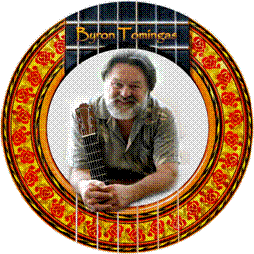 |
After teaching literally thousands of guitar students,
for many years, Tomingas does not offer private lessons anymore, only master
classes.
Refreshingly non-judgmental, non-ego oriented and respectful in approach, the Maestro custom tailors’ well balanced instruction, targeted specifically to personal musical goals. In addition, he does not lock into a rigid generalized formula, each session is custom tailored to ones interests, needs and rapid advancement through enthusiasm. |
email [email protected] |
|
| Return to Top | |
| The Traveling Soprano Guitar:
|
|
| Originally,
a Ukulele was purchased for $12 in Maui so the Maestro could teach his then, 2
year old daughter who had an obvious talent and keen interest in music. Retuned like a violin and restrung
with a thick lower string graduating to thinner across, the instrument proved
to be creative fountain for Tomingas. The purchase of another Ukulele was obviously required. Guitarist Tomingas now plays the
“Soprano Guitar” in between every task, on walks it’s in
the backpack if not in his magical hands. He has composed a considerable body of
work for the instrument and transcribed many classics as well as pop and folk
songs. As to his choice of tuning
he says, “The length of the neck makes a tuning like a violin quite
logical due to the reach of the hand, a side benefit is that this tuning
alleviates the a problem inherited by the Ukulele when it borrowed the worst
part of guitar tuning, the highest four strings. The problem in guitar tuning is that
when they added the highest string, suddenly all the chords became difficult
to play as it seemed you had to always keep a finger on the new high string. Some exceedingly clever person, whose
name is lost to history, figured out that if they dropped the pitch of the 2nd string to B, then the other strings work out wonderfully for basic chords and
so this became the standard. The
problem is that having one illogically tuned string makes scale and chord
patterns far more complex as you move across strings rendering scales
difficult. The keyboard,
which became the piano, has a
similar problem that was also caused by quirk of evolution where it was based
on the letters of the musical alphabet and the musical alphabet was designed
before sharps and flats became musically popular. A better design would be to
eliminate the “missing” keys concept and the whole thing would
improve in all regards.
|
|
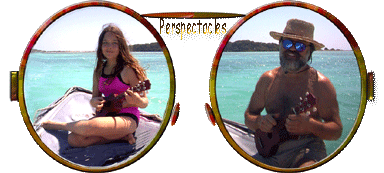 |
My
favorite on ‘points of ergromic logic’ like this, was when the
inventor of the typewriter had a problem with people becoming too good at
typing and breaking his machines, so he scrambled the letters where weak
fingers would have most used letters slowing the typists down, we now live
with that even though the machines can reach incredible speeds. The Dvorak typewriter keyboard is far
more logical, but how many people do you know that use it? Same problem with the musical
mistakes, once they are second nature, no one wants to try and change
it. No one wants to change a
guitars tuning, nor probably a Ukulele, however, this little wonderful
traveling companion is now a Soprano Guitar full of capabilities, I’ve
played Bach, Rodrigo, Grieg, Oriental songs, Blues, hilarious Rock renditions
and I’ve written, actually I should say the instrument inspired
numerous compositions, some quite sophisticated, others playful and energized
”
|
Byron Paul Tomingas & his musically talented daughter Persis Anne Tomingas lived aboard their Yacht “Callisto” in Key West Florida, Dry Tortugas and Cozumel Mexico 2002-2004 and Whittier Alaska 2005-2006 “raising musical havoc with the natives” and now in Jackson Hole where Byron is the Native! The slide show of Byron and his daughter Persis Anne Tomingas includes the Jackson Hole Figure Skating Club's "Nutcracker on Ice" with Byron skating the part of Godfather Droselmeir. |
|
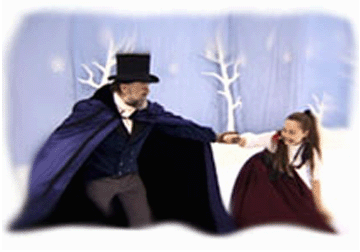 |
 |
| Return to Top | |
Reviews of Byron Paul Tomingas, Guitar |
|
 |
|
“
Brilliant” Nevada State Journal
“Absolute
Magic” Angela Smith, SC
“Phenomenal Response” Guitar News of England
“Velvet Fingers” Guy Olsen Whittier Inn Alaska
“Splendid Musicality” Jack
Neal, Classical Review
“
Our magnificent Guitarist
“
Bill Briggs, Jackson Hole
“
Determined, skillful and articulate”
“
Dr. Louis M. Soffer “Concerts fine tuned to the heart of the audience” Guy Horn
“A great musician and well known genius” Arnie Gamble, Luthier
“One hell of a guitar player!” Recording Engineer, Monterey, CA
“That
(performance) raises folk music to a whole new level” Bill Briggs
“Music just seems to flow out of his
fingertips” unknown concert patron
“He stunned (the audience) ~ performing Rodrigo’s
Concierto” John Cooke
“I want to write music for you” Maestro Roman Ryterband, Classical
Composer*
“A leading force in music of this kind” Classical Radio Commentator Euell Labhard
“On a scale of 1 – 10
your guitar scored a 11! Lenny Sorrenson-Cobb, Sound Engineer
“Enchanted Animation” Ephran
Younger, Vice President Carmel Classic Guitar Festival
“Indeed a Virtuoso and a credit
to the music world” E. W. Hopper, Hollywood Film Producer
“You
don’t hear many people who can even play it (Rodrigo’s Fandango)
let alone play it at that level” Richard Spross, Music Instructor, Monterey CA “
He turns anything into a masterpiece so we’ll end it here because no one can top
that” Bill Briggs, Founder; Jackson Hole Hootenanny
“The variety of tonal
nuances with which he expresses himself is seemingly limitless”,
Carmel Classic Guitar Festival Board
of Directors
“To say Byron Tomingas is a man
of many talents is barely scratching the surface”
John Cooke, Author, Performer
“
I wondered if the standing ovation Mr. Tomingas received, (at the Carmel Classic Guitar Festival) was in
any way indicative of the audience’s sophistication in matters musical”
(NOTE: this last comment was not
written to be complimentary, just the opposite in fact, he was not only
insulting me but the audience of peer professionals so I have included it
here for a balanced perspective, as I said at that concert, I have no loftier
reason for choosing the material I play other than each one has charmed my
heart and I therefore enjoy spending time with them. - Byron)
*Sonata for Guitar by Roman Ryterband was written for Tomingas, one of the last works of this master composer. The score now resides at the Harvard Music Library along with correspondence between Tomingas and Ryterband |
|
|
 |
[email protected]
Command Concert ProgramsP. O. Box 1032 Jackson Hole, WY 83001 USA
|
|
Other Links of Interest
·
Ocean Explorers
Charter Ships
·
Expeditionary
Yacht: Callisto
·
Over The Top
Expedition
·
2aT Technologies, LLC
·
COGignition, LLC
·
Daughter Persis
Anne’s “eVoidWorks.com”
·
Tomingas Computer Engineering
·
Tomingas Family History
·
Duo Tomingas
Return to Top
Copyright © 2003 & 2009 Tomingas, all rights reserved,permission required for use of any part of this Web page |
 |